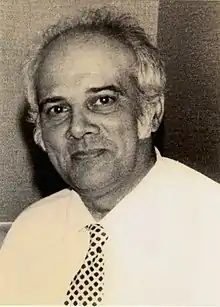Archeosofica
Archeosofica is a school of esoteric Christianity founded by Tommaso Palamidessi in 1968 in Rome. It offers a program of research and of experimental results, by supplying Booklets and other textbooks in which the most important subjects of Archeosophy, i. e. “Science of Principles”, are developed.[1][2]

The school requires neither a fee nor the subscription of any membership. The school of Archeosofica is free and offers a program of research and of experiments by supplying booklets and other texts. The foundation of Archeosofica is rooted in Palamidessi's spirit of collaboration on the spiritual realisation of man and woman.[3][4][5][6][7][8] According to Tommaso Palamidessi, Archeosofica is
an esoteric school that prepares for Initiation: a free school for free scholars, who must not feel like pupils nor apprentices, but brothers who listen to the living voice of other brothers, or who wish to doctrinate themselves by their writings that present the results of serious studies and experiences: Brothers who have started out with a mentality free of prejudices and who have analyzed, chosen and accepted the best of all the other ancient and modern esoteric schools.[9]
It is a call addressed to all, and it does not matter if they belong to the different communities (Theosophists, Anthroposophists, Martinists, Rosicrucians, Catholics, Yoghists, etc.). The Brotherhood is only one, and it can have only one verb: Love one another; only one Master: Jesus the Christ.[9]

Tommaso Palamidessi's thought about co-operation and fraternal spirit and is repeated more than once in his works and reveals the idea which inspired the foundation of Archeosofica
...we are all brothers and we must unite, love each other and work together. The Ecumenical Council is not only of the religions, but also of the esoteric societies. The times require the co-operation of all, and we offer a Way which is safe, swift, direct, towards the overcoming of one's own moral, psychic, spiritual and biological state.[10]
Archeosofica and the integral Ascesis
Archeosofica proposes an integral Ascesis, composed, that is, of other integrative asceses which we enumerate as follows:[2][11] [12]
- Physiological and Psychosomatic Ascesis, for the physical well being and the maximum balance and performability of the body, its energies, to the purpose of making it a temple of the spirit: a necessary basis for preparing a good karma (destiny) in view of the resurrection of the body, healthy and beautiful.
- Social Ascesis that is the effort, exercise, methodical and progressive action to become a perfect citizen and to make oneself a spokesman of a new society resting on the pillars of charity, non-violence, reciprocal economic, cultural and spiritual assistance.
- Mystical Ascesis, through an intense devotional life of dialogue with the Divinity; a process of inner transmutation leading to active ecstasy, to the vision of the Light. It is the Alchemist's Opus in White, the entrance into the Waters of Life, the sojourn of the Saints: prelude to a new state of superior ascent towards the Kingdom of God.
- Theurgical Ascesis, or progressing with the rites which attract the friendship and help of God, of the Christ, of the Mother, of the helpful Angelic Spirits, Archangelic and of the Universal Communion of the Adepts and the Saints.
- Magical Ascesis, effort and action to dominate the forces of Nature. Read the definition of Magic we have given in our Encyclopedic Dictionary of Archeosophy (40th Booklet - first part).
- Cosmic Ascesis, action and advance towards a syntony or cosmicization with the whole: stars, elements, skies, etc.
- Sapiential and Initiatic Ascesis, or the spiritual elevation of oneself through the Knowledge and particular practices leading to an inner transmutation and to the qualitative leap. It is the way to come out of the Waters of the phenomenic world, the going beyond the mystical state, it is the christic walking above the Waters. It is the perennial wakefulness and the Alchemist's Opus in Red, that is the royal state of who has finally exited from the game of creation.
All these forms of ascesis are explained as doctrine and as practice in special booklets called "Archeosophy Booklets".
Archeosophy Booklets
Subjects of Archeosophy are developed in special booklets called Archeosophy Booklets. There are about 50 Booklets which investigate various subjects as esoteric Christianity, Reincarnation, Out of Body Experience, Meditation, Clairvoyance, Esotericism, Alchemy, Symbolism, Mysticism, Pranotherapy, and so on.[13]
Some bibliography from Archeosofica
- Tommaso Palamidessi, The Archaic Tradition and Foundation of Archeosophical Initiation
- Il Corso degli astri e le malattie nell'uomo: trattato teorico-pratico di cosmopatogenesi con 22 figure, Milan: F.lli Bocca, 1940 (2nd ed. Archeosofica 1985).
- La medicina e gli influssi siderali, Milan: F.lli Bocca, 1940.
- Astrologia mondiale: il destino dei popoli rivelato dal corso degli astri, Turin: T. Palamidessi, 1941 (2nd ed. Archeosofica 1985).
- Gli influssi cosmici e la diagnosi precoce del cancro, Turin: T. Palamidessi, 1943.
- Terremoti, eruzioni e influssi cosmici, Turin: T. Palamidessi, 1943.
- I poteri occulti dell'uomo e lo yoga tantrico indo-tibetano, Turin: Spartaco Giovene, 1945 (2nd ed. Archeosofica 1988, 3rd ed. ArkeiosISBN 9788886495233 ).
- La tecnica sessuale dello yoga tantrico indo-tibetano, Turin: Edizioni Grande Opera, 1948 (2nd ed. Archeosofica 1988, 3rd ed. Arkeios ISBN 9788886495226).
- La potenza erotica di kundalini yoga: lo yoga del potere serpentino ed il risveglio dei ventuno chakra, Turin: Grande Opera, 1949.
- Lo yoga per non morire: metodi sperimentali indù per realizzare l'immortalità autocosciente, Turin: Grande Opera, 1949.
- L'alchimia come via allo spirito: l'autorealizzazione magica e la psicologia del profondo, svelate dalla tradizione ermetica, Turin: Grande Opera, 1949 (2nd ed. Arkeios 2001).
- Gli astri nella diagnosi e cura del cancro, Turin: Ed. Grande Opera, 1949.
- Tecniche di risveglio iniziatico: i centri di forza e la metafisica sperimentale, Rome : Edizioni Mediterranee, 1975 (2nd ed. 1983).
- Archeosofia, 5 volumes, Rome: Archeosofica, 1985-1988 (2nd ed. Arkeios 2001, ISBN 9788886495264).
- Il libro cristiano dei morti, Rome: Arkeios, 1985.
- Le basi della teologia sofianica : nuove indagini bibliche, Rome: Arkeios, 1986.
- L'icona, i colori e l'ascesi artistica: dottrina ed esperienze per una Via verso l'autosuperamento ed una coscienza divina nell'arte, Rome: Arkeios, 1986.
- Ricettario Erboristico, Rome: Arkeios, 1987.
References
- World Religion and Spirituality Project: https://wrldrels.org/2020/02/19/archeosophy/
- Palamidessi Tommaso, THE ARCHAIC TRADITION AND FOUNDATIONS OF ARCHEOSOPHICAL INITIATION, first Booklet, Archeosofica, 1968
- Cresti, F. (2020). Archeosofia, scuola Archeosofica, Associazione Archeosofica. La libertà religiosa e l’unità delle religioni. The Journal of CESNUR, 4(1), 108–120. Disponível em: https://cesnur.net/wp-content/uploads/2020/01/tjoc_4_1_5_cresti.pdf. Doi: https://doi.org/10.26338/tjoc.2020.4.1.5
- Corradetti, D., & Lullo, G. (2020). L’Archeosofia e la metafisica sperimentale di Tommaso Palamidessi, ovvero la pratica spirituale. The Journal of CESNUR, 4(1), 31–54. Disponível em: https://cesnur.net/wp-content/uploads/2020/01/tjoc_4_1_3_corradetti.pdf. Doi: https://doi.org/10.26338/tjoc.2020.4.1.3
- Zoccatelli, P. (2020). Tommaso Palamidessi, l’Archeosofia, e lo studio dell’esoterismo. The Journal of CESNUR, 4(1), 4–7. Disponível em: https://cesnur.net/wp-content/uploads/2020/01/tjoc_4_1_1_zoccatelli.pdf. Doi: https://doi.org/10.26338/tjoc.2020.4.1.1
- Introvigne, M. (Ed.). (2020). The Journal of CESNUR. The Journal of CESNUR (Vol. 4). Torino: CESNUR. Disponível em: https://cesnur.net/wp-content/uploads/2020/01/tjoc_4_1_full_issue.pdf
- Lullo, G. (2020). Tommaso Palamidessi (1915-1983). Cenni biografici e opere del fondatore dell’Archeosofia. The Journal of CESNUR, 4(1), 7–30. Disponível em: https://cesnur.net/wp-content/uploads/2020/01/tjoc_4_1_2_lullo.pdf. Doi: https://doi.org/10.26338/tjoc.2020.4.1.2
- Di Marzio, R. (2020). Diventare archeosofi. Percorsi di cambiamento e sviluppo personale. The Journal of CESNUR, 4(1), 55–107. Disponível em: https://cesnur.net/wp-content/uploads/2020/01/tjoc_4_1_4_dimarzio.pdf. Doi: https://doi.org/10.26338/tjoc.2020.4.1.4
- Palamidessi Tommaso, 3rd Booklet of Archeosophy, ed Archeosofica, 1968
- Palamidessi Tommaso, 1st Booklet of Archeosophy, ed Archeosofica, 1968
- Encyclopedia of New Religious Movements, the article on "Archeosophy" by P.L. Zoccatelli in Peter B. Clarke (ed.), Londra - New York: Routledge, 2006, p. 38-39.
- C. Gatto Trocchi, Magia ed esoterismo in Italia, Milano: Mondadori, 1990, p. 142-145.
- A complete list of the booklets can be found on the Archeosophical Society site Archived 2015-02-02 at the Wayback Machine
External links
- The Official Site of the Archeosophical Society
- The Official Site of the Italian Archeosofica